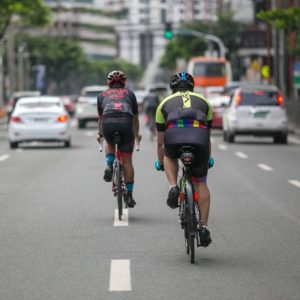A colleague of mine chatted with me on the elevator going down and out of the office recently. She had asked for tips about how to improve her confidence while riding, as her on-the-saddle nervousness was detracting from the time she could spend with her kids while they gleefully rode their own bikes.
I figured this would make for a good subject for today’s writeup. So, how do you become a more confident bike rider?
SADDLE TIME – AND MORE OF IT
Unfortunately, there isn’t a magic shortcut or an instant cure that will take away your jitters. The best way of building confidence on the saddle is to simply keep riding your bike.
Or is it?
As starkly simple as that advice is, it’s too simple and doesn’t give you much of anything to focus on. A more effective strategy is to break down the task of riding into individual skills you can practice when you do log the saddle time.
EMERGENCY STOPS
This is first on my skills list for good reason. The laws of physics dictate that vehicles with one front wheel just don’t stop as quickly as those with two or more. There are things we can do to improve the odds, though, regardless of what brake system you run on your bike.

Befriend your front brake; it is crucial if you want to stop quickly. Key to making use of it correctly without flipping over your handlebars is to straighten out your bike, get your pedals level, stand up out of the saddle, and push your hips backward as you pull the front brake lever. In a sense, you are pushing the bike away as you brake. This counterweighting action basically makes it impossible for you to fly forward off your bike. Pull on both front and rear brake levers, but bias the front brake more.
It is imperative you practice and get used to this skill quickly, because it can literally save your life. Regular practice recommended.
RIDING ONE-HANDED

Easily second on my list is one-handed riding. If you have any plans of riding on the street with vehicular traffic, you will need some way of visually indicating your intentions, and the best way of doing this is with hand/arm signals.
Freeing one hand from your handlebars also allows you to drink or eat while riding, and allows you to turn your waist and head more so you can check for traffic behind you.
So how do you teach yourself to ride one-handed? Take advantage of your speed, as it’s how a bicycle stays upright and stable. At a medium riding pace, around 12 km/h and faster, try to have one hand let go of the handlebars while going straight, and let the loose hand hover a few centimeters over the bar, so you can hold it again if needed. You’ll soon find out that you don’t have to grip the handlebars all that tightly to maintain stability.
RIDING AT VERY SLOW SPEED
Having established that a bicycle is more balanced and stable the faster it goes, what do you do when you take away the speed? You become more active and work to maintain your balance.
This is an excellent skill to learn, one for more advanced riders. It’s also great to go back and practice every once in a while. Without speed, you are forced to constantly tweak your balance on the bike, making adjustments with the handlebars and leaning your body left and right. It’s effective both done in a straight line and while turning or going round in a tight circle.
The good news is that all this low-speed balance work translates directly into better bike handling at higher speeds. On a fast road ride, especially, you can get used to steering the bike with your hips instead of your handlebars.
RIDING IN A STRAIGHT LINE

This might sound too simplistic, but you actually do need to intentionally practice riding in a straight line. Why? I see too many bike riders who cannot ride straight without flopping their wheels over left and right. Imagine the cold bullets of sweat you’d feel having to ride alongside such a cyclist.
The constant need for left-right correction while riding straight just means a rider cannot keep balance well. Much like in car racing, the more you move the steering wheel, the slower you ultimately are. While a fast pace on the saddle isn’t top of everybody’s priorities, I bet most people want to ride without having to needlessly expend energy doing anything else but go forward.
Practicing this is as simple as finding a white line on the side of the road and trying to keep yourself as parallel to it as possible – or even ride over it if conditions allow. Again, the side effect is you learn to steer your bike using your hips, rather than your hands. For added challenge, drop your speed and hold the straight line at a very slow pace.
